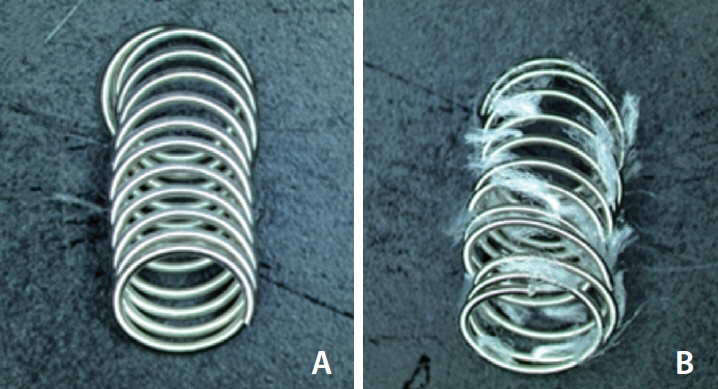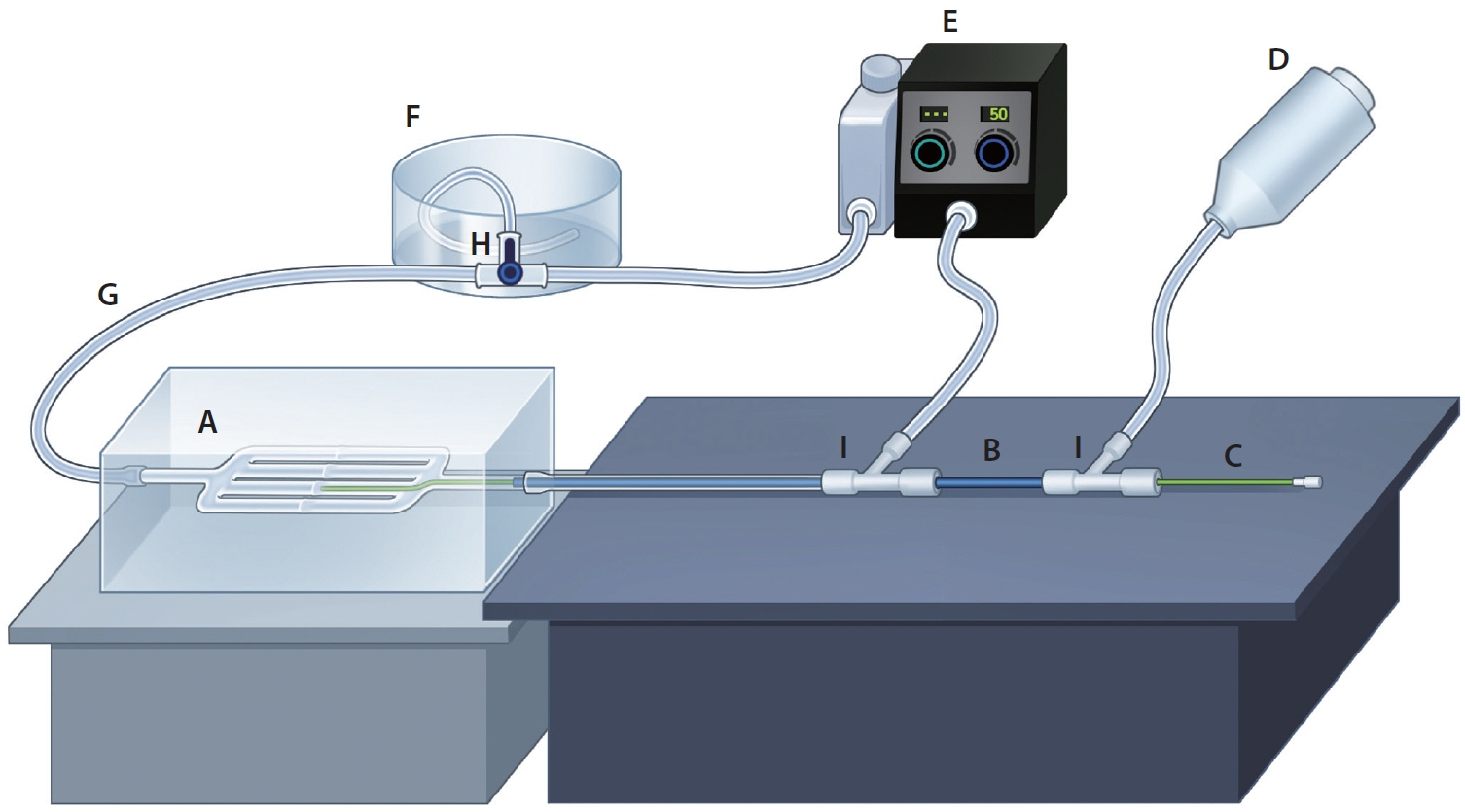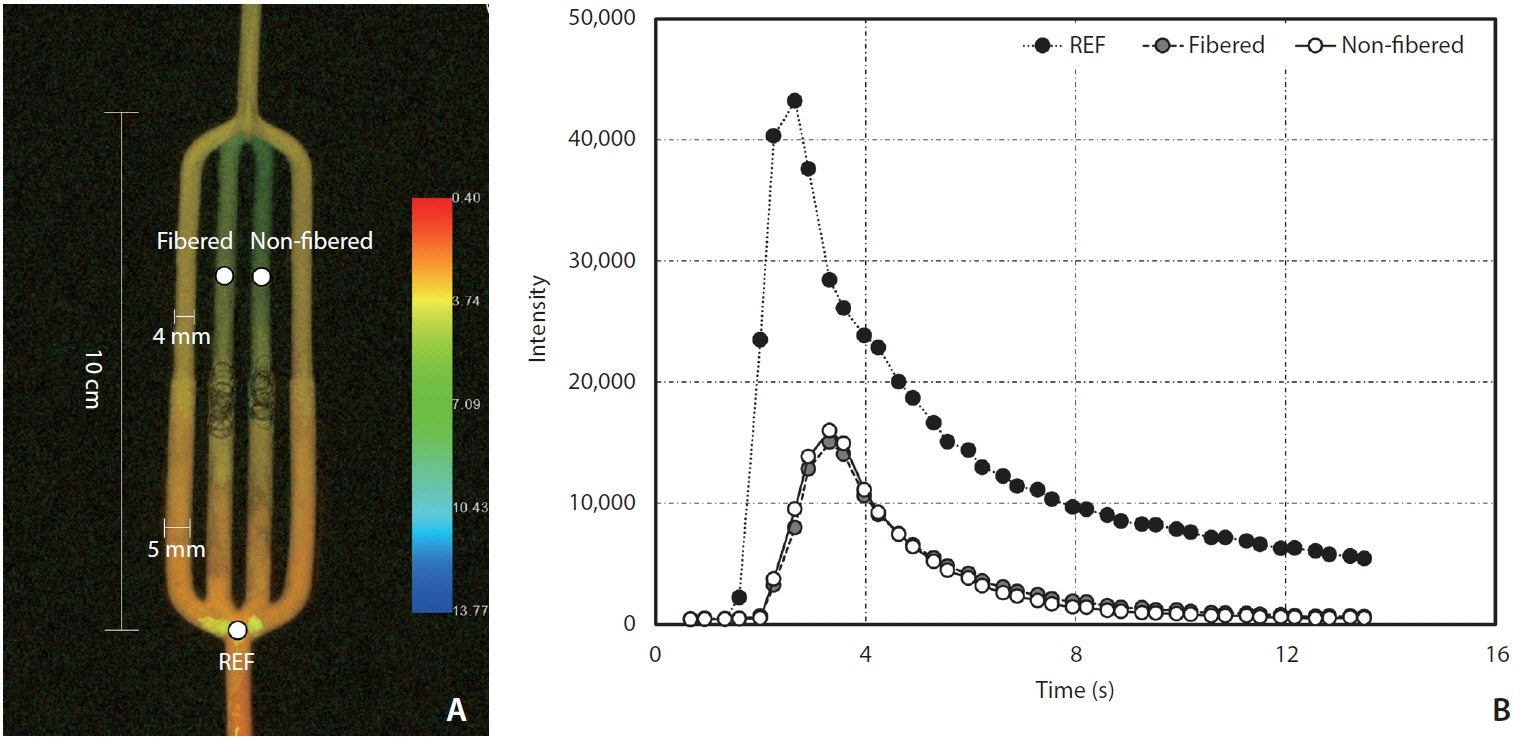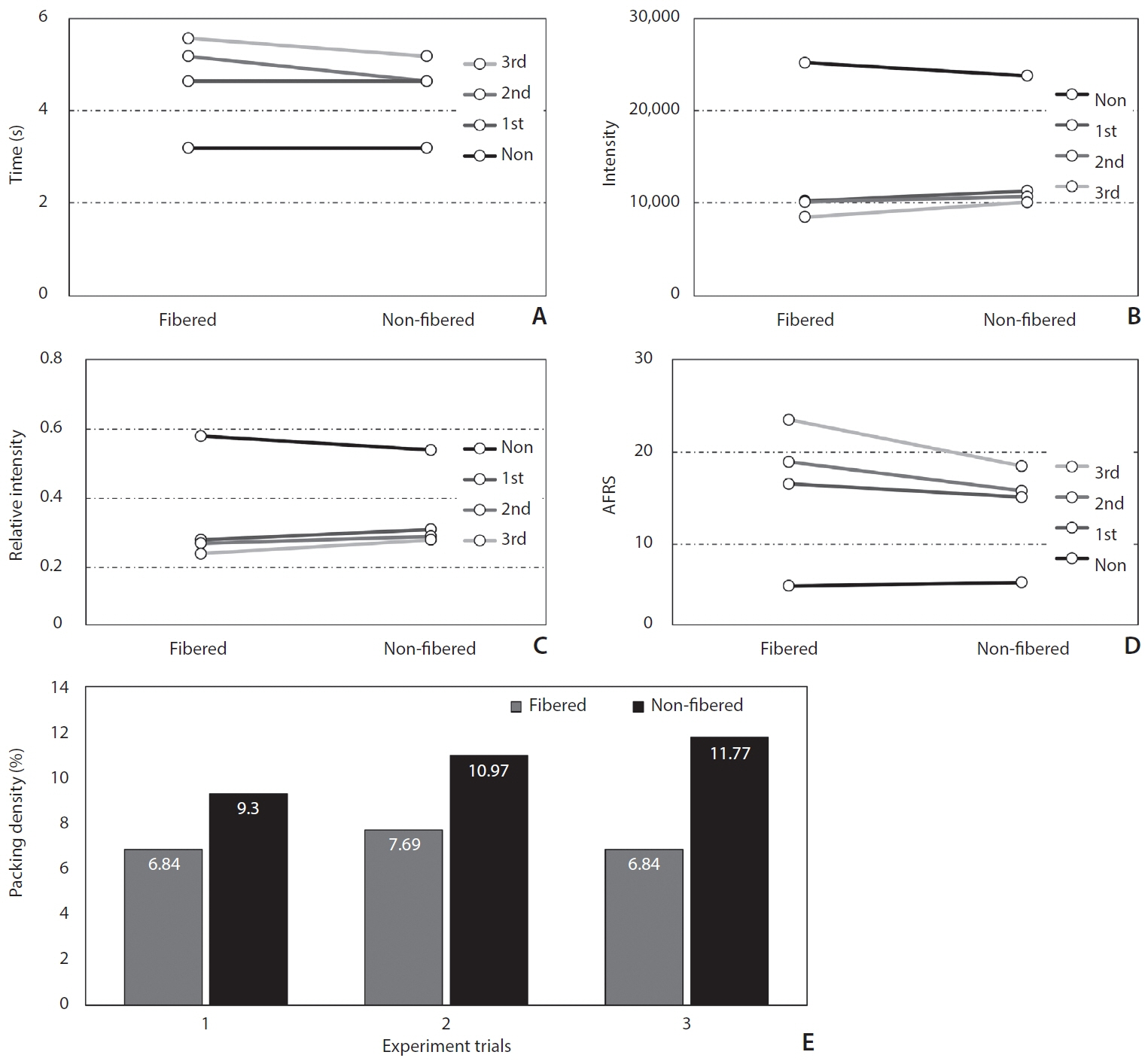Neurointervention.
2024 Mar;19(1):31-38. 10.5469/neuroint.2024.00031.
In Vitro Head-to-Head Comparison of Flow Reduction between Fibered and Non-Fibered Pushable Coils
- Affiliations
-
- 1Department of Radiology, AMIST, Asan Medical Center, University of Ulsan College of Medicine, Seoul, Korea
- 2Department of Radiology, Asan Medical Center, University of Ulsan College of Medicine, Seoul, Korea
- KMID: 2552877
- DOI: http://doi.org/10.5469/neuroint.2024.00031
Abstract
- Purpose
To compare the embolization effects of a non-fibered pushable coil with a conventional fibered pushable coil in an in vitro bench-top experiment.
Materials and Methods
A simplified vascular phantom with 4 channels (1 for the non-fibered coil, 1 for the fibered coil, and 2 for continuous circuit flow) was used. A single coil of the longest length was inserted to evaluate the effect of single-coil embolization, and 3 consecutive coils were inserted to assess the effect of multiple-coil embolization. Post-embolization angiography was performed to obtain flow variables (time to peak [TTP], relative peak intensity [rPI], and angiographic flow reduction score [AFRS]) from time density curves. The packing densities of the two coil types were calculated, and the AFRS of each channel was determined by dividing the TTP by the rPI.
Results
When inserting a single coil, the conventional fibered coil demonstrated better flow reduction, as indicated by a higher AFRS (25.6 vs. 17.4, P=0.034). However, the non-fibered coil exhibited a significantly higher packing density (12.9 vs. 2.4, P=0.001). Similar trends were observed with multiple coils.
Conclusion
The conventional fibered pushable coil showed better flow reduction efficiency, while the non-fibered pushable coil had a higher packing density, likely due to the flexibility of the coil loops. A better understanding of the distinct characteristics of different pushable coils can enhance the outcomes of various vascular embolization.
Keyword
Figure
Reference
-
1. Gianturco C, Anderson JH, Wallace S. Mechanical devices for arterial occlusion. Am J Roentgenolog. 1975; 124:428–435.
Article2. Girdhar G, Read M, Sohn J, Shah C, Shrivastava S. In-vitro thrombogenicity assessment of polymer filament modified and native platinum embolic coils. J Neurol Sci. 2014; 339:97–101.
Article3. Fohlen A, Namur J, Ghegediban H, Laurent A, Wassef M, Pelage JP. Peripheral embolization using hydrogel-coated coils versus fibered coils: short-term results in an animal model. Cardiovasc Intervent Radiol. 2018; 41:305–312.
Article4. Patel PJ, Arko FR 3rd. Ruby® Coil and POD® System: a coil platform for fast and easy embolization. Insert Endovasc Today. 2018; 17:22–29.5. Zander T, Medina S, Montes G, Nuñez-Atahualpa L, Valdes M, Maynar M. Endoluminal occlusion devices: technology update. Med Devices (Auckl). 2014; 7:425–436.
Article6. Yasumoto T, Osuga K, Yamamoto H, Ono Y, Masada M, Mikami K, et al. Long-term outcomes of coil packing for visceral aneurysms: correlation between packing density and incidence of coil compaction or recanalization. J Vasc Interv Radiol. 2013; 24:1798–1807.
Article7. Vogler J 4th, Gemender M, Samoilov D. Packing density and long-term occlusion after transcatheter vessel embolization with soft, bare-platinum detachable coils. Am J Interv Radiol. 2020; 4:2.
Article8. Leyon JJ, Littlehales T, Rangarajan B, Hoey ET, Ganeshan A. Endovascular embolization: review of currently available embolization agents. Curr Probl Diagn Radiol. 2014; 43:35–53.
Article9. Kye SM, Ahn JH, Lee HS, Kim JH, Oh JK, Song JH, et al. Transvenous coil embolization of hypoglossal canal dural arteriovenous fistula using detachable coils: a case report. J Cerebrovasc Endovasc Neurosurg. 2022; 24:166–171.
Article10. Park KY, Kim JW, Kim BM, Kim DJ, Chung J, Jang CK, et al. Coil-protected technique for liquid embolization in neurovascular malformations. Korean J Radiol. 2019; 20:1285–1292.
Article11. Barr JD, Lemley TJ. Endovascular arterial occlusion accomplished using microcoils deployed with and without proximal flow arrest: results in 19 patients. AJNR Am J Neuroradiol. 1999; 20:1452–1456.12. Dudeck O, Bulla K, Wieners G, Ruehl R, Ulrich G, Amthauer H, et al. Embolization of the gastroduodenal artery before selective internal radiotherapy: a prospectively randomized trial comparing standard pushable coils with fibered interlock detachable coils. Cardiovasc Intervent Radiol. 2011; 34:74–80.
Article13. Irie T. New embolization microcoil consisting of firm and flexible segments: preliminary clinical experience. Cardiovasc Intervent Radiol. 2006; 29:986–990.
Article14. Hui FK, Fiorella D, Masaryk TJ, Rasmussen PA, Dion JE. A history of detachable coils: 1987-2012. J Neurointerv Surg. 2014; 6:134–138.
Article15. Lee JW, Kim DJ, Jung JY, Kim SH, Huh SK, Suh SH, et al. Embolisation of indirect carotid-cavernous sinus dural arterio-venous fistulae using the direct superior ophthalmic vein approach. Acta Neurochir (Wien). 2008; 150:557–561.
Article16. Kwon B, Song Y, Hwang SM, Choi JH, Maeng J, Lee DH. Injection of contrast media using a large-bore angiography catheter with a guidewire in place: physical factors influencing injection pressure in cerebral angiography. Interv Neuroradiol. 2021; 27:558–565.
Article17. Gölitz P, Luecking H, Hoelter P, Knossalla F, Doerfler A. What is the hemodynamic effect of the Woven EndoBridge? An in vivo quantification using time-density curve analysis. Neuroradiology. 2020; 62:1043–1050.
Article18. Trerotola SO, Pressler GA, Premanandan C. Nylon fibered versus non-fibered embolization coils: comparison in a swine model. J Vasc Interv Radiol. 2019; 30:949–955.
Article19. Fohlen A, Namur J, Ghegediban H, Laurent A, Wassef M, Pelage JP. Midterm recanalization after arterial embolization using hydrogel-coated coils versus fibered coils in an animal model. J Vasc Interv Radiol. 2019; 30:940–948.
Article20. White SB, Wissing ER, Van Alstine WG, Trerotola SO. Comparison of fibered versus nonfibered coils for venous embolization in an ovine model. J Vasc Interv Radiol. 2023; 34:888–895.
Article21. White RI, Pollak JS. Controlled delivery of pushable fibered coils for large vessel embolotherapy. In: Golzarian J, Sun S, Sharafuddin MJ. Vascular embolotherapy: a comprehensive approach. Vol. 1, General principles, chest, abdomen, and great vessels. Springer, 2006;35-42.22. Haug S. Tools of the trade. In: Keefe N, Haskal Z, Park A, Angle J. IR playbook: a comprehensive introduction to interventional radiology. Springer, 2018;27-53.23. Pech M, Kraetsch A, Wieners G, Redlich U, Gaffke G, Ricke J, et al. Embolization of the gastroduodenal artery before selective internal radiotherapy: a prospectively randomized trial comparing platinum-fibered microcoils with the Amplatzer Vascular Plug II. Cardiovasc Intervent Radiol. 2009; 32:455–461.
Article24. Maleux G, Deroose C, Fieuws S, Van Cutsem E, Heye S, Bosmans H, et al. Prospective comparison of hydrogel-coated microcoils versus fibered platinum microcoils in the prophylactic embolization of the gastroduodenal artery before yttrium-90 radioembolization. J Vasc Interv Radiol. 2013; 24:797–803. quiz 804.
Article25. Guirola JA, Sánchez-Ballestin M, Sierre S, Lahuerta C, Mayoral V, De Gregorio MA. A randomized trial of endovascular embolization treatment in pelvic congestion syndrome: fibered platinum coils versus vascular plugs with 1-year clinical outcomes. J Vasc Interv Radiol. 2018; 29:45–53.
Article
- Full Text Links
- Actions
-
Cited
- CITED
-
- Close
- Share
- Similar articles
-
- Author Correction: In Vitro Head-to-Head Comparison of Flow Reduction between Fibered and Non-Fibered Pushable Coils
- Giant High-Flow Type Pulmonary Arteriovenous Malformation: Coil Embolization with Flow Control by Balloon Occlusion and an Anchored Detachable Coil
- A Case of Dural Arteriovenous Fistula of the Anterior Condylar Vein
- Endovascualr Treatment for Traumatic Giant Pseudoaneurysm of Internal Carotid Artery
- Direct Carotid Cavernous Fistula of an Adult-Type Persistent Primitive Trigeminal Artery with Multiple Vascular Variations





